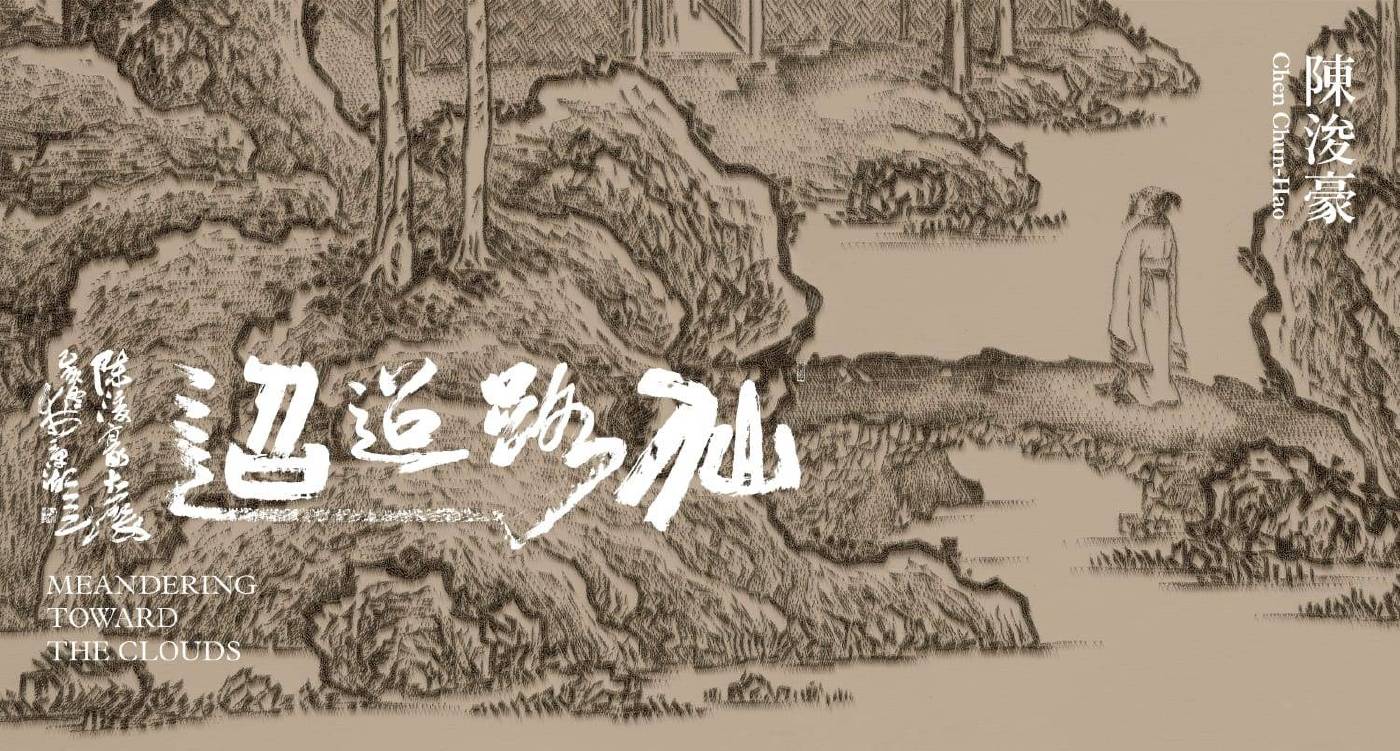耿畫廊
【仙路迢迢 Meandering Toward the Clouds】陳浚豪個展

-
展期
日期:2020-02-15 ~ 2020-03-22
-
地點
耿畫廊 / 114 台北市內湖區瑞光路548巷15號1樓
-
參展藝術家
-
耿畫廊將於2020年新春舉辦「仙路迢迢」陳浚豪個展,帶來「蚊釘山水」系列新作。延續以當代工業生產要素:蚊釘為媒材,在筆墨技法與材質語彙的錯置中,細密陣列的蚊釘由點、線成面,透過立影同觀者視角對舞,將經典水墨的焦濃淡清越度至當代思維下的臨場光影閱讀。對應著陳浚豪一年多來從內而外的心境轉折,在即將邁入知天命之年的現今,由轉譯原作鋪陳的臨摹系列,到自運成章的「石仙乾坤」、「女媧」系列。這行至十年的臨摹之途,從今已然蔓生嶄新篇章枝節,彷彿在錯置的時空中重新運墨,透顯與傳統書畫道統中遙相應和的當代文人精神。
數以萬計的蚊釘在釘槍氣動擊發下一根根植入畫面,彷彿鐫刻關於藝術生產與勞動的微妙辯證——陳浚豪的創作不僅是利用工業化器械回應中國古典美學,更是在原作的水墨框架中尋求超越的可能性。當柔光穿越濃密的針點,暈透的立影彷彿凝結為灰階染出的氤氳濃霧,隨觀者視角偏移交織出浮動而立體的層次,綿延成疏密有致的山水丘壑。畫中疊嶂起伏的山巖巒層讓人不禁聯想至水墨大家張光賓散點漫佈的「焦墨散點皴」,經蚊釘開拓展延為存在立體維度的獨特皴法;而陳浚豪以獨創技法新譯各家經典繪卷的同時,透過既有文本的挪用、仿擬與再造,形成情節的懸置,乃至於敘事意義的顛覆與新生,在已然熟悉畫史的觀者眼下,更加激盪出另一種閱讀的可能。
展覽中完成於2019年的《玉女神宮》和《女媧神宮》別具分水嶺意味,乃陳浚豪以蚊釘進行創作以來,首見未以「臨摹」為體的系列新作。喜愛單車出遊的陳浚豪經常於閒暇時造訪台灣各地,對於地方宮廟建築中繁複繽紛的雕飾格外有感,進而將素來挪用歷代中國書畫名跡的創作方向,拉回腳下所踩的這塊土地——以創建至今近兩百年的宜蘭壯圍補天宮(一般即通稱為女媧廟)與台北關渡宮旁的玉女宮為題材,繪寫台灣在地廟埕美學奇趣;而仙氣繚繞的兩件作品《石仙乾坤.蕉風》、《石仙乾坤.凝鹿》,以雲霧圍繞著的巨石奇岩,點綴著橫伸而出的蕉葉與靜坐前望的祥鹿,營造出宛如仙山靈洞的滌俗氛圍。畫面主體乍看與人們常見的太湖石質地相彷,實則來自北海岸野柳獨特的地景結構,充分體現與在地緊密連結的創作情感,為身處台灣的觀者開創出另種觀看的趣味。
2019年初,陳浚豪將工作室搬遷至北投的鐵皮廠房,赫然發現所在地劃分於「八仙里」行政區內;回看宮廟屋脊及山牆飾畫中常見的「八仙過海」題材,立時因藝術家身處的「八仙里」而鮮活起來。而「八仙」所分別代表的男、女、老、少、富、貴、貧、賤,一個個來自現實社會階層與境況而最終修練升仙的形象,就某種意義而言,正是藝術家不斷尋找可能、打開想像,進而不斷突破個人進境的寫照。陳浚豪帶著對於自己生命經驗的濃郁情懷,以及斯土斯民的文化認同,以獨特的「蚊釘山水」為引,邀請觀者踏上仙氣繚繞的奇崛地景,於尋幽訪勝的迢迢仙路上,一同觀照新譯山水所譜出的人間異境。
-
關於陳浚豪
1971年出生於台灣南投,1998 年取得台南藝術大學造型藝術研究所碩士學位。
自1997年開始,陳浚豪即運用大量製造的工業化「圖釘」作為創作媒材,在空間中、畫布上以理性安排點、線、面的造型構成與光學原理,讓觀者藉由位移而能夠對作品獲得不同感知,在台灣當代藝術圈中獨樹一格。直至 2009 年底,開始以「蚊釘」創作。利用木工裝潢時所使用的特殊「蚊釘槍」,進行古畫的臨摹創作。對他來說,這樣的臨摹是極為個人式的創作行為,同時也延續了先前的創作慣性 ─ 「在材質的限制性下尋找創作的可能性」。陳浚豪運用蚊釘與傳統書畫的水墨置換,視個人的臨摹為「再創作」的創作方式,將眾多書畫典範,以當代書寫的方式,賦予其嶄新的面貌。
陳浚豪曾舉辦多次個展,包括:台北耿畫廊的「仙路迢迢」(2020)、「天圓.地方.非人間」(2017)、「還我河山」(2014)與「蚊釘山水」(2011)、VT 非常廟藝文空間「陳浚豪個展 — 之乎者也」(2010) 、「迷宮個展」(2007)、台東鐵道藝術村「花花帳個展」(2006)、華山藝文特區「瀉銀個展」(2002)、20 號倉庫「個展 — 潛在氛圍Ⅱ」(2002)、台北市立美術館「個展 — 潛在氛圍」(2001)。
----
Tina Keng Gallery is pleased to present Chen Chun-Hao: Meandering Toward the Clouds. The solo exhibition showcases a series of new works featuring Chen’s unique mosquito nail shanshui. Employing industrial nails as a prominent medium, Chen has developed over the years a complex dialogue between the technique of traditional ink paintings and an emphasis on materiality. On his canvas, planes are composed by an intense formation of dots and lines, capturing a vivid interplay of light and shadow that successfully translates classical ink art into a contemporary sensibility of presence and immediacy.
Meandering Toward the Clouds chronicles Chen’s psychological ups and downs over the past year at a critical moment as he turned 50. As the occasion celebrates a culmination of a decade-long journey where Chen has dedicated his artistic energy to paying homage to the tradition of emulation while generating new possibilities for his now signature technique, the solo exhibition comprises his famed emulation series, as well as new works from the “Stone Fairy” and “Nuwa” series. This not only initiates a brand-new narrative juxtaposing time and space, but also underpins a contemporary rendition of the classical literati spirit, inherited from the legacy of traditional ink painting and the practice of calligraphy.
As tens of thousands of nails are punctured through the canvas by a nail gun, the operation presents a nuanced debate of labor in the process of artistic production. This critical discussion is made possible by Chen’s use of industrial mechanics as his response to a classical Chinese aesthetics, breaking the original frameworks created by the historical works of ink art he emulated. Shadow and darkness enable a sequence of atmospheric grayscale imagery, while light travels through a thick cloud of nailheads. A dynamic picture of mountains and valleys spans across the canvas as the viewer’s line of vision changes.
Chen’s nail rendition of landscape is a natural reminder of the “dotted texturization with charred ink” technique developed by the late calligraphy master Chang Kuang-Bin. With the help of his personalized wrinkle method, Chen’s unique approach further provides a sense of depth on a two-dimensional surface. As Chen reinterprets classical paintings from a wide variety of styles and schools, he on the one hand appropriates, emulates, and recreates the originals, while on the other hand produces a dramatic suspense to subvert the initial narratives of the original works, by generating new meanings with his alternative readings.
Lady Jade Temple and Nuwa Temple, both completed in 2019, stand as the stylistic watershed of Chen’s career. As the first body of works not based on his emulation of previous masters, these distinct recent artworks were instead grounded on Chen’s enthusiasm for cycling and the richly ornated reliefs and decors often seen in the local temples that he encountered along his many trips around Taiwan. These experiences and encounters also became an opportunity for Chen to change gear from his long-time appropriation of prestigious historical Chinese paintings, to a close examination of the island where he resides. The prototype of the architecture in this new series came from the now 200-year-old Butian (or Nuwa) Temple of the Zhuangwei Township in Yilan County, as well as the Lady Jade Temple next to the Guandu Temple in Taipei.
As for the mystical works of Stone Fairy, The View South and Stone Fairy, Deer at Rest, the two paintings depict monumental rock formations shrouded by clouds and mist — one dotted with banana leaves and the other featuring an auspicious deer — creating a transcendental atmosphere which evokes the land of the immortals. The texture of the rocks in these paintings is reminiscent of Taihu’s porous stone at first glance, but in fact Chen took inspiration from Yehliu’s unique landscape in the North Coast of Taiwan. By so doing, Chen demonstrates an intimate affinity with local Taiwanese culture.
In this sense, Meandering Toward the Clouds manifests Chen’s life journey and cultural identity that is fixated on the land he resides. Chen’s mosquito nail shanshui serves as his ultimate invitation for the viewer to tour a celestial mindscape which infuses new meanings into a traditional form.
About Chen Chun-Hao
Born 1971 in Nantou, Taiwan, Chen Chun-Hao received a master’s degree in plastic arts from the National Tainan University of the Arts (1998). Since 1997, Chen has experimented with the use of industrial materials in his work, such as thumbtacks. For the “Mosquito Nail Shan Shui” series, Chen carefully emulates landscape paintings found at the National Palace Museum, Taipei and abroad, by placing diminutive mosquito nails on canvas. After precise calculations, for his first completed piece, Early Spring for the Mosquito Nail (2010), Chen used a specially designed nail gun to place as many as 400,000 stainless steel mosquito nails on canvas. Enlarging the original Early Spring (1072), he then carefully replaced the ink of the scroll with the mosquito nails, which protrude about one centimeter from the canvas. Each nail punctures the surface of the canvas, at the same time conjuring a three-dimensionality that accentuates the work’s otherworldliness.
Chen Chun-Hao has participated in numerous exhibitions, including at the Today Art Museum, Beijing, China (2009), Taipei Fine Arts Museum, Taiwan (2001, 2006), Museum of Contemporary Art, Taipei, Taiwan (2005), and Headlands Center for the Arts in Sausalito, California, U.S. (2002). His solo exhibitions include Meandering Toward the Clouds, Tina Keng Gallery, Taipei (2020); Once Upon an Otherworldly Realm, Tina Keng Gallery, Taipei (2017); Reclaiming the Lost Territories, Tina Keng Gallery, Taipei (2014); Mosquito Nail Shan Shui, Tina Keng Gallery, Taipei (2011); The Way of Nailing, VT Artsalon, Taipei (2011); Maze, VT Artsalon, Taipei; and Aura Beyond, Taipei Fine Arts Museum, Taipei (2001).


